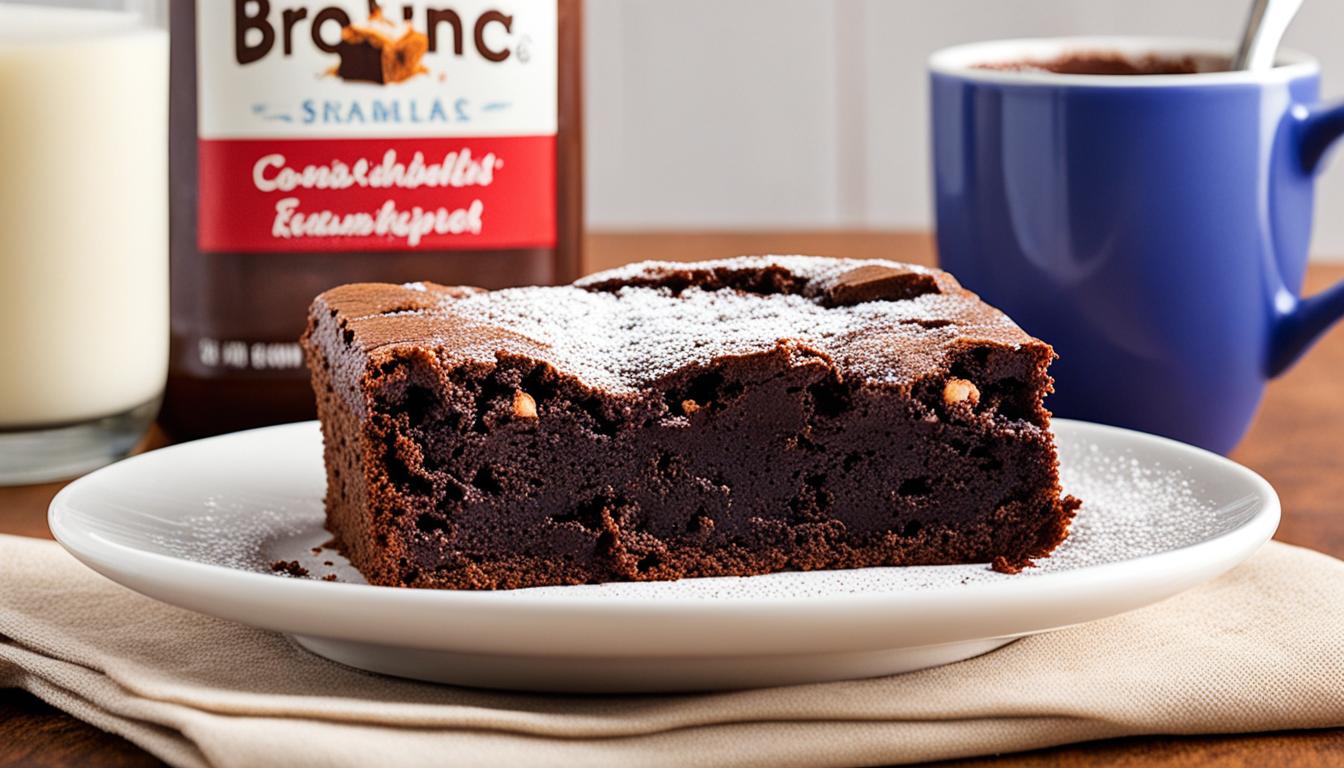Do brownie recipes need baking powder? It’s a question that may challenge your beliefs about this beloved dessert. Many of us have grown accustomed to the light and cake-like texture in our brownies. But what if I told you that baking powder may not be necessary for achieving that perfect brownie? Prepare to have your brownie-baking assumptions turned upside down as we explore the role of baking powder in creating the ultimate brownie experience.
Contents
- 1 The Perfect Brownie Recipe Without Baking Powder
- 2 Storing Brownies for Freshness
- 3 Understanding the Role of Eggs in Brownie Texture
- 4 Baking Soda Vs. Baking Powder in Brownies
- 5 The Importance of Leavening Agents in Baked Goods
- 6 Determining Freshness of Baking Powder and Baking Soda
- 7 Differentiating Baking Powder and Baking Soda
- 8 Conclusion
- 9 FAQ
- 9.1 Do brownie recipes need baking powder?
- 9.2 What is a delicious brownie recipe that does not require baking powder?
- 9.3 How should brownies be stored for freshness?
- 9.4 What role do eggs play in the texture of brownies?
- 9.5 What are the differences between baking soda and baking powder in brownies?
- 9.6 Why are leavening agents important in baking?
- 9.7 How can I determine the freshness of baking powder and baking soda?
- 9.8 What are the differences between baking powder and baking soda?
- 9.9 What can I conclude about baking powder in brownie recipes?
- 10 Source Links
Key Takeaways:
- Brownie recipes can be made without baking powder, resulting in a dense and fudgy texture.
- The omission of baking powder allows for a more moist and chewy brownie.
- Eggs play a crucial role in the texture and structure of brownies.
- Understanding the differences between baking soda and baking powder is important for successful baking.
- Experimenting with different recipes and techniques can help you find your perfect brownie recipe.
The Perfect Brownie Recipe Without Baking Powder
Looking for a delicious homemade brownie recipe that doesn’t require baking powder? Look no further! This one-bowl recipe will satisfy your sweet tooth and leave you craving for more. Let’s dive into the details and discover the secrets to baking perfect brownies without the need for baking powder.
To start, gather the following ingredients:
- 1 cup of unsalted butter
- 4 ounces of baking chocolate
- 1/2 cup of cocoa powder
- 1 teaspoon of instant coffee (optional)
- 2 teaspoons of vanilla extract
- 1/2 teaspoon of almond extract
- 2 cups of granulated sugar
- 4 large eggs
- 1 cup of all-purpose flour
- 1/2 teaspoon of salt
Now, let’s proceed with the baking process:
- Preheat your oven to 350°F (175°C) and grease a 9×13 inch baking dish.
- In a saucepan, melt the butter and baking chocolate over low heat, stirring occasionally until smooth. Remove from heat.
- Add the cocoa powder, instant coffee (if desired), vanilla extract, almond extract, and granulated sugar to the mixture. Mix well.
- Add the eggs, one at a time, stirring well after each addition.
- In a separate bowl, whisk together the flour and salt.
- Gradually add the flour mixture into the chocolate mixture, stirring until just combined. Be careful not to overmix.
- Pour the batter into the greased baking dish and spread it evenly.
- Bake in the preheated oven for 23-25 minutes, or until a toothpick inserted into the center comes out with a few moist crumbs.
- Remove from the oven and allow the brownies to cool completely before cutting into squares.
Voila! You’ve just baked a batch of fudgy and rich brownies without the use of baking powder. The result? A crackly top, chewy edges, and a delectably fudgy center that will have everyone asking for seconds.
Note: The image above represents the final result of the homemade brownie recipe without baking powder.
Tips for Perfect Brownies:
Here are some additional tips to elevate your brownie game:
“To achieve the perfect texture, do not overmix the brownie batter. Overmixing can result in a dense and tough brownie instead of the desired fudgy texture.”
| Tip | Description |
|---|---|
| Use High-Quality Chocolate | Using high-quality chocolate will greatly enhance the flavor of your brownies. |
| Add Mix-Ins | Experiment with adding nuts, chocolate chips, or even a swirl of peanut butter for added deliciousness. |
| Let the Brownies Cool Completely | Allowing the brownies to cool completely before cutting ensures clean edges and prevents them from crumbling. |
| Store Properly | Store the brownies in an airtight container at room temperature for up to 5 days to maintain freshness. |
Now that you have the perfect brownie recipe without baking powder and some handy tips, it’s time to put on your apron and start baking. Prepare to indulge in a heavenly treat that will delight both your taste buds and those lucky enough to share in your homemade brownie goodness.
Storing Brownies for Freshness
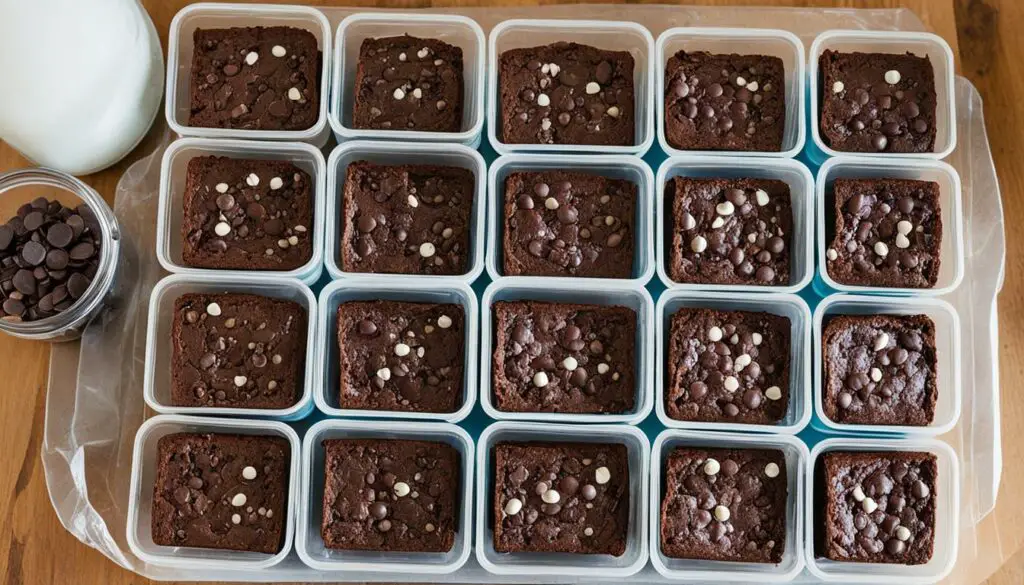
Proper storage is essential to ensure the freshness and deliciousness of your brownies. Follow these tips to keep your brownies tasting their best.
Room Temperature Storage
When storing brownies at room temperature, it’s important to use an airtight container to prevent them from drying out. Place the brownies in a container with a tight-fitting lid to maintain their moisture and flavor. Storing brownies this way will keep them fresh for up to 5 days.
Freezing for Long-Term Storage
If you want to extend the shelf life of your brownies, freezing is a great option. Here’s how to do it:
- Cut the brownies into individual pieces.
- Wrap each piece tightly in plastic wrap to prevent freezer burn.
- Wrap the individual pieces in aluminum foil for extra protection.
- Place the wrapped brownies in a freezer bag or airtight container.
- Label the container with the date of freezing.
- Store the brownies in the freezer for up to three months.
Note: Freezing brownies is a convenient way to have a sweet treat on hand whenever you crave one. Just thaw them at room temperature for a few hours or microwave them for a quick warm-up.
Remember, proper storage not only keeps your brownies fresh but also maintains their texture and taste. Enjoy your delicious brownies even days after baking!
Understanding the Role of Eggs in Brownie Texture
Eggs play a crucial role in achieving the perfect texture for your brownies. When it comes to baking essentials for brownies, eggs are a key ingredient that you shouldn’t overlook. The protein present in eggs coagulates during the baking process, resulting in a firm and structured brownie. This coagulation allows the brownie batter to rise to its maximum height, creating a dense and chewy texture that is beloved by many brownie enthusiasts.
Not only do eggs contribute to the texture, but they also enhance the flavor and richness of your brownies. The richness of the egg yolks brings a depth of flavor, while the egg whites provide moisture that keeps your brownies moist and delicious.
To better understand the role of eggs in brownie texture, consider this insightful quote:
The protein in eggs gives brownies their structure and chewiness. Without eggs, the texture of brownies would be completely different. They truly are an essential ingredient.
So, when you’re following brownie baking tips, don’t forget to include eggs in your recipe. Whether you prefer fudgy, chewy, or cake-like brownies, eggs are a fundamental component in achieving the desired texture and flavor. Experiment with different variations and quantities to create your perfect batch of brownies.
Benefits of Eggs in Brownies
| Benefits | Description |
|---|---|
| Texture | Eggs contribute to the chewiness and structure of brownies, resulting in a dense and satisfying texture. |
| Flavor | The richness of eggs enhances the overall flavor profile of brownies, adding depth and complexity. |
| Moisture | Egg whites provide moisture, ensuring that your brownies stay moist and delicious. |
Baking Soda Vs. Baking Powder in Brownies
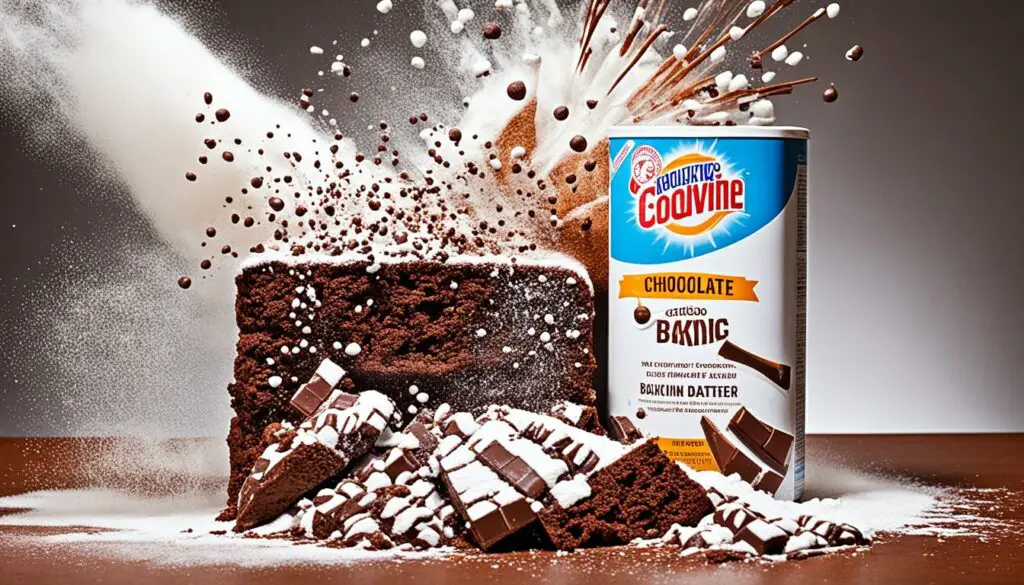
Baking soda and baking powder are commonly used leavening agents in baking, and their use can significantly impact the texture and flavor of brownies. Understanding the role of these ingredients is crucial when perfecting your brownie recipe.
Baking soda, also known as sodium bicarbonate, requires the presence of an acid, such as cocoa powder or yogurt, to create a chemical reaction that produces carbon dioxide gas. This gas then creates bubbles and helps the brownies rise during baking. The use of baking soda can result in a more browned color and crispy edges in brownies.
On the other hand, baking powder is a combination of baking soda, an acid, and a stabilizer. It already contains the necessary acid component, eliminating the need for additional acidic ingredients. Baking powder acts as a complete leavening system, releasing carbon dioxide gas when combined with liquid and heat. This can give brownies a lighter and fluffier texture, making them more cake-like.
When deciding between baking soda and baking powder for your brownies, consider the desired texture and flavor profile you want to achieve. If you prefer a dense and fudgy brownie with a rich chocolate flavor, baking soda may be the better choice. If you prefer a lighter and more cake-like brownie, baking powder would be more suitable.
It’s important to note that the amount of baking soda or baking powder used in a recipe can also affect the final result. Too much leavening agent can cause the brownies to rise excessively, creating a cakier texture. It’s best to follow a tested and trusted recipe or experiment with different ratios to find the perfect balance for your taste preferences.
The Differences Between Baking Soda and Baking Powder in Brownies:
| Baking Soda | Baking Powder |
|---|---|
| Requires an acidic ingredient for activation | Contains both acid and base components for self-activation |
| Can result in a more browned color and crispy edges | Can result in a lighter and fluffier texture |
| Best suited for dense and fudgy brownies | Best suited for lighter and cake-like brownies |
Remember, there is no right or wrong choice between baking soda and baking powder in brownies. It ultimately depends on your personal preference and the texture you desire. Feel free to experiment with both leavening agents to find the perfect balance and create brownies that satisfy your taste buds.
The Importance of Leavening Agents in Baked Goods
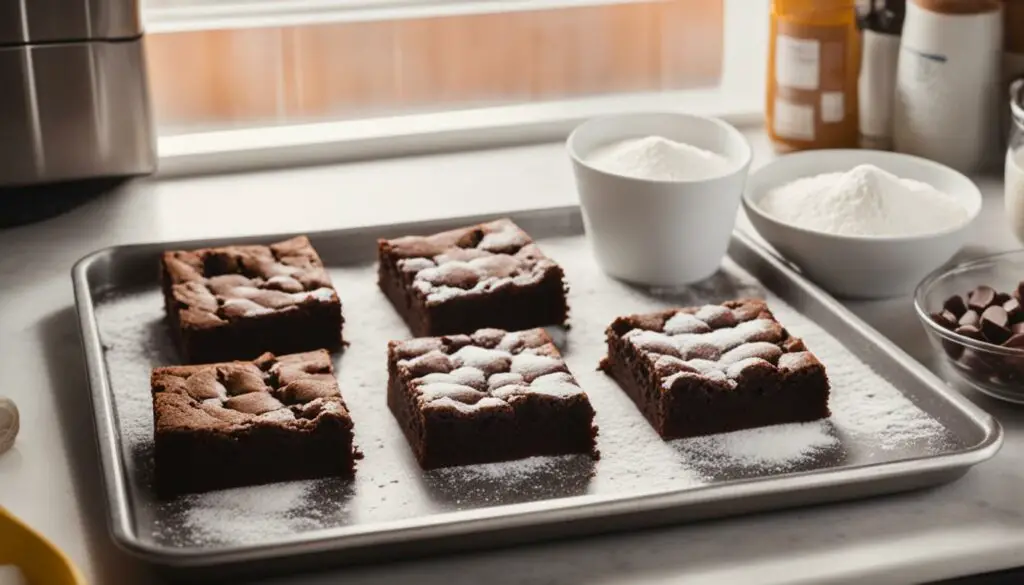
Leavening agents play a crucial role in creating light and fluffy textures in baked goods. Two commonly used leavening agents are baking powder and baking soda. These agents release gases, especially carbon dioxide, during the baking process, resulting in the formation of bubbles within the batter or dough.
These bubbles expand and create a rise and lift, leading to a lighter and less dense final product. The proper use of leavening agents is essential to achieve the desired texture in various baked goods, be it cakes, cookies, or muffins.
Baking powder, in particular, is highly revered for its versatility and convenience. It consists of both an acid and a base component, making it a complete leavening system. This eliminates the need for additional acidic ingredients in the recipe, unlike baking soda. Baking powder’s ability to create a significant amount of gas during baking contributes to the overall tenderness and flavor of baked goods.
On the other hand, baking soda requires the presence of acidic ingredients, such as buttermilk or vinegar, to activate and produce carbon dioxide gas. This chemical reaction creates bubbles and contributes to the rise and lightness of various baked goods. Baking soda is particularly useful when a browned color and crispy edges are desired.
The proper balance of leavening agents is crucial for achieving the desired texture and taste in baked goods. Too much or too little leavening agent can adversely affect the final product. It is essential to refer to reliable recipes and measurements to ensure the right amount of leavening agents are used.
| Leavening Agent | Key Purpose |
|---|---|
| Baking Powder | Creates a rise and lift, contributes to tenderness and flavor |
| Baking Soda | Produces gas to create bubbles and contribute to rise and lightness |
The appropriate use of leavening agents is fundamental to successful baking. They are responsible for creating the fluffy textures, tender crumbs, and delightful flavors that we love in baked goods.
Determining Freshness of Baking Powder and Baking Soda
Baking powder and baking soda are essential ingredients in many baking recipes, but they can lose their effectiveness over time. It’s important to ensure that these leavening agents are fresh to guarantee the best results in your baked goods. Here are simple tests to determine the freshness of baking powder and baking soda:
Testing Baking Soda:
- In a small bowl, mix a teaspoon of baking soda with a small amount of vinegar.
- Observe whether the mixture bubbles vigorously.
- If the baking soda and vinegar mixture bubbles vigorously, it indicates that the baking soda is fresh.
- If there are no bubbles or a minimal reaction, it’s time to discard the baking soda and replace it with a fresh batch.
Testing Baking Powder:
- In a small bowl, mix a teaspoon of baking powder with hot water.
- Check for a bubbling reaction. Fresh baking powder will produce bubbles when mixed with hot water.
- If there is no bubbling reaction or a minimal reaction, it’s a sign that the baking powder has lost its effectiveness.
- Dispose of the old baking powder and purchase a new container for optimal results in your baking.
By regularly checking and replacing expired or ineffective baking powder and baking soda, you can ensure that your baked goods rise properly and have the desired texture. Freshness is key to achieving the best results in baking!
Differentiating Baking Powder and Baking Soda
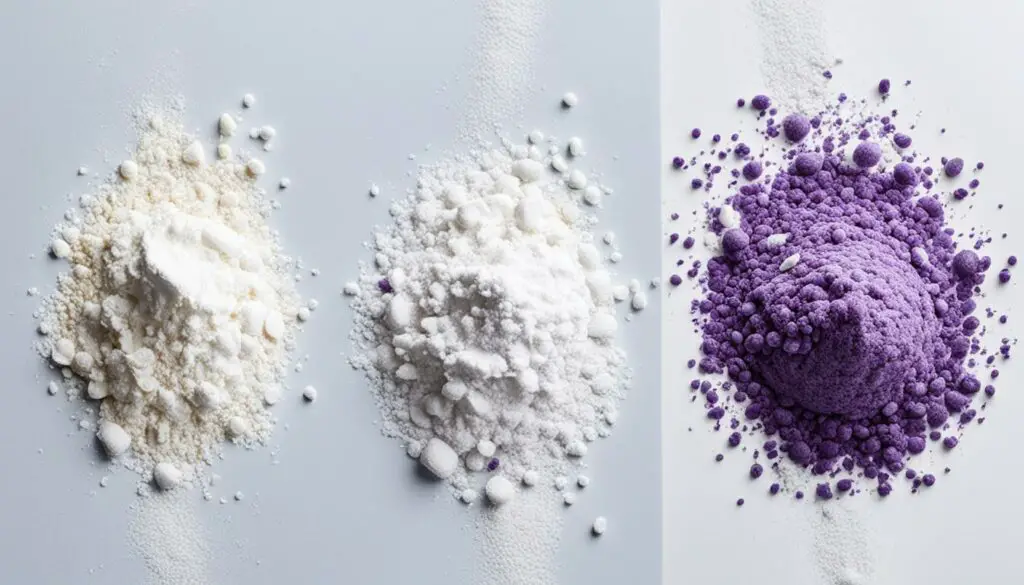
When it comes to baking, understanding the differences between baking powder and baking soda is crucial. While both are leavening agents, they have distinct characteristics that can significantly impact the outcome of your baked goods.
Baking Soda
Baking soda, also known as sodium bicarbonate, is a pure alkaline substance. Unlike baking powder, it does not contain any acidic components. Instead, it relies on the presence of moisture and acid in the recipe to activate and release carbon dioxide gas. This gas forms bubbles in the batter or dough, causing it to rise and create a lighter texture.
For baking soda to function properly, it needs acidic ingredients such as yogurt, vinegar, buttermilk, or lemon juice. These acidic components react with the baking soda to create carbon dioxide gas, resulting in a rise in the baked goods. Without these acidic ingredients, the baking soda may remain inactive, leading to dense and flat baked goods.
Baking Powder
Baking powder, on the other hand, is a complete leavening system in itself. It is a mixture of baking soda, an acid like cream of tartar, and an anti-caking agent. The acid component in baking powder provides the necessary acidity for the reaction to occur, allowing the release of carbon dioxide gas.
Unlike baking soda, baking powder can be activated by both moisture and heat. This means it can produce carbon dioxide gas during the initial mixing and throughout the baking process. The inclusion of an acid component in baking powder eliminates the need for additional acidic ingredients in the recipe.
It’s important to note that there are different types of baking powder available in the market. Some are labeled as “double-acting” baking powder, which means they release gas both during mixing and baking. Others are labeled as “single-acting,” which release gas only during the baking process.
Differences between Baking Powder and Baking Soda:
| Baking Soda | Baking Powder |
|---|---|
| Requires acidic ingredients for activation | Contains both acid and base components |
| Produces bubbles to create a lighter texture | Releases gas during mixing and baking |
| Can result in a denser texture without acidic ingredients | Does not rely on additional acidic ingredients |
Baking soda and baking powder are both versatile leavening agents, each with unique properties that impact the texture and rise of baked goods. Understanding their differences allows you to make informed decisions and achieve desired results in your baking endeavors.
Conclusion
In the ultimate brownie guide, we have explored the necessity of baking powder in brownie recipes. If you prefer a dense and fudgy texture, you can omit baking powder. By doing so, you will create a more moist and chewy brownie that is sure to satisfy your sweet tooth.
Eggs also play a crucial role in achieving the desired brownie texture. The protein in eggs coagulates during baking, resulting in a firm and structured brownie. The presence of leavening agents like baking soda and baking powder can affect the rise and fluffiness of brownies, so it’s important to understand their differences and how they can impact your recipe.
To become the ultimate brownie master, don’t be afraid to experiment with different recipes and techniques. Find the perfect combination of ingredients and baking methods that suit your preferences. Whether you prefer a classic recipe or want to try something new, the key is to have fun and enjoy the process of creating delicious homemade brownies.
FAQ
Do brownie recipes need baking powder?
Brownie recipes can be made without baking powder, resulting in a dense and fudgy texture. The omission of baking powder allows for a more moist and chewy brownie, as the lack of this leavening agent prevents the formation of air bubbles, which would result in a cake-like texture. However, the choice to include or exclude baking powder depends on personal preference and the desired texture of the brownies.
What is a delicious brownie recipe that does not require baking powder?
A delicious brownie recipe that does not require baking powder involves melting butter and chocolate in a saucepan, and then adding cocoa powder, instant coffee, vanilla extract, almond extract, sugar, eggs, flour, and salt. The batter is then poured into a greased baking dish and baked at 350°F for 23-25 minutes. This one-bowl recipe results in fudgy and rich brownies with a crackly top and a mix of chewy edges and a fudgy center.
How should brownies be stored for freshness?
Brownies are best stored at room temperature in an airtight container. They can stay fresh for up to 5 days in proper storage. For longer storage, individual pieces of baked brownies can be wrapped in plastic wrap and aluminum foil, and then frozen for up to three months. Proper storage helps maintain the flavor and texture of the brownies.
What role do eggs play in the texture of brownies?
Eggs play a crucial role in the texture of brownies. The protein in eggs coagulates during baking, resulting in a firm and structured brownie. The coagulation of protein allows the batter to rise to its maximum height and create a dense and chewy texture. Additionally, eggs contribute to the flavor and richness of the brownies.
What are the differences between baking soda and baking powder in brownies?
Baking soda and baking powder are chemical leavening agents that can affect the texture of brownies. While baking soda requires acidic ingredients in the recipe to activate and produce gas, baking powder contains both acid and base components, making it a complete leavening system. The use of baking soda can lead to a more browned color and crispy edges in brownies, while baking powder can result in a lighter and fluffier texture.
Why are leavening agents important in baking?
Leavening agents, such as baking powder and baking soda, are essential in creating light and fluffy textures in baked goods. They release gases, particularly carbon dioxide, during the baking process, which forms bubbles in the batter or dough. These bubbles expand and create a rise and lift, resulting in a lighter and less dense final product. Leavening agents also contribute to tenderness and flavor in baked goods.
How can I determine the freshness of baking powder and baking soda?
To test the freshness of baking soda, mix it with vinegar and observe if it bubbles vigorously. If it does not, it should be discarded and replaced. Similarly, to test the freshness of baking powder, mix it with hot water and check for bubbling. If there is no reaction, it is time to replace the baking powder.
What are the differences between baking powder and baking soda?
Baking soda is a pure alkaline substance that activates in the presence of moisture and acid. It requires acidic ingredients in the recipe to function properly. On the other hand, baking powder is a combination of baking soda, an acid like cream of tartar, and an anti-caking agent. It can be activated by moisture and heat and does not rely on additional acidic ingredients.
What can I conclude about baking powder in brownie recipes?
In conclusion, baking powder is not necessary in brownie recipes if a dense and fudgy texture is desired. The omission of baking powder allows for a more moist and chewy brownie. Eggs play a role in creating the desired texture, while leavening agents like baking soda and baking powder can affect the rise and fluffiness of brownies. Understanding the differences between baking soda and baking powder is important for successful baking. By experimenting with different recipes and techniques, one can find the perfect brownie recipe that suits their preferences.

